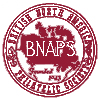According to Geoffrey Whitworth (The Five Cents Beaver Stamp of Canada, The Royal Philatelic Society, London, 1985), one plate of 100 subjects was prepared for the 1859 5 Cents Beaver stamp. The plate was reworked ten times, and thus exists in 11 states.
In some cases, the appearance of a flaw for particular plate state changed due to plate wear. Whitworth used plate "substates" to document such changes, and appended a letter to the plate state number to indicate a substate. For example, there are substates of states 2, 4, and 6. They are labelled 2a, 4a, and 6a.
This page displays images of the plate flaws, and provides easy navigation to any stamp position and plate state. Whitworth numbered the flaws he documented, as did Clayton Huff, an earlier researcher who published his findings in BNA Topics. The Whitworth (WW) and Huff numbers are given in the flaw descriptions below.
Some researchers have suggested that more than one plate was used and/or the plate(s) consisted of more than one pane. See, for example, the article "Is There More Than One Plate For The 5c Beaver?" by Michael D. Smith, Dots and Scratches, Vol.6, No.4, Sept. 2019.
Select the state (includes substates)
| 1 | 2 | 3 | 4 | 5 | 6 | 7 | 8 | 9 | 10 | 11 |
Plate map for state 8
| 1 | 2 | 3 | 4 | 5 | 6 | 7 | 8 | 9 | 10 | |
| 1 | 8 | |||||||||
| 7| 9 | 5| | 7| | 5| | 7| | 6| | 3| | 7| 9 | 7| | 2| | |
| 2 | ||||||||||
| 7| 9 | 6| | 3| | | 9 | | 10 | ||||||
| 3 | 8 | |||||||||
| 6| | 7| 9 | | 11 | | 11 | 7| | ||||||
| 4 | 8 | 8 | 8 | |||||||
| 3| 9 | 7| | | 10 | 4| | | 11 | 4| | 5| 10 | 7| | |||
| 5 | 8 | 8 | ||||||||
| 7| | 3| | 4| | 7| 10 | 4| | | 9 | | 10 | 3| | |||
| 6 | 8 | 8 | ||||||||
| 7| | 1| 9 | | 10 | 4| 10 | |||||||
| 7 | ||||||||||
| 7| | 4| | 4| | 7| 10 | 3| | ||||||
| 8 | 8 | 8 | ||||||||
| 7| 9 | 5| 9 | 4| 9 | 5| | 6| | 3| 11 | |||||
| 9 | 8 | |||||||||
| 6| | 3| 9 | 6| | | 10 | 4| 10 | ||||||
| 10 | 8 | |||||||||
| 4| | 7| 10 | 6| 9 | 6| | 5| 10 | 7| 9 | | 9 |
How to use the plate map
Each cell in the plate map represents a plate position. Each cell has two colour-coded rows.
Row 1 - current state
Stamp image and/or flaw data available
No stamp image or flaw data available
Row 2 - nearest lower and higher states
Nearest lower state with stamp image and/or flaw data. Nothing for higher states.
Nearest higher state with stamp image and/or flaw data. Nothing for lower states.
Nearest lower and higher states with stamp image and/or flaw data
No stamp image or flaw data for any lower or higher state
The state numbers indicate what is available:
- 5 (black, bold) - Stamp image and flaw data
- 5 (black) - Only stamp image
- 5 (red, bold) - Only flaw data
The state numbers are links. Click on the state to view the stamp image and flaw data for that state.
Copyright © 2015 - 2025 The British North America Philatelic Society.
The documents on this website are for informational and non-commercial or personal use only.
Documents on this website shall not be used on other websites or for
commercial purposes without permission.
This page was last modified on 2024-09-02.
